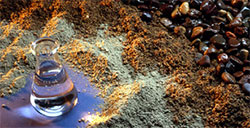When receiving a specification for “crystalline waterproofing” or “integral waterproofing”, there are a number of factors to consider. The product choice made can directly affect the quality of the concrete. Using the wrong waterproofing product for the job at hand can compromise quality, or even affect the concrete producer’s profit per unit.
What Are Integral Waterproofing Systems?
These systems work within the concrete itself to make the entire concrete structure a waterproof barrier
There are two main types of integral waterproofing systems: the hydrophilic and the hydrophobic systems.
FOLLOWING THE SPECIFICATION When You Get the Opportunity to Select a Waterproofing Admixture, Just What Are You Selecting?
Crystalline-based systems typically come in a dry, powdered form and are hydrophilic in nature. Unlike their hydrophobic counterparts, crystalline systems actually use available water to grow crystals inside concrete, effectively closing off pathways for moisture that can damage concrete. They block water from any direction because the concrete itself becomes the water barrier.

The right waterproofing admixture can improve the quality of the concrete product, and make
a positive difference to the concrete producer’s bottom line.
In contrast to water repellents, crystalline technologies enable self-sealing. The admixture is a blend of cementitious and proprietary chemicals that actually work with the available water in concrete to form insoluble crystals. These needle-like crystals grow until all pores are blocked and no water can penetrate the concrete. The crystalline formula can allow concrete to self-seal hairline cracks up to 0.5 mm (0.02 in.), even years after the original construction.
What Does This Mean to the Concrete Producer?
By selecting a hydrophilic crystalline waterproofing admixture in the appropriate circumstance, the concrete is optimized for the job. This means that not only is the quality and performance of the product improved – but the bottom line of the concrete producer’s profit and reputation are positively influenced.
Many concrete producers already familiar with this type of crystalline waterproofing have enhanced their product line with a branded, waterproof mix. By including a hydrophilic crystalline admixture they can rely on, many have multiplied their profit per cubic meter.
Concrete that is waterproofed using a hydrophilic crystalline admixture affords other benefits, too. It contains no VOCs from this admixture, and can be easily recycled when demolition occurs. Any contractor or owner looking to obtain LEED points, or reduce the environmental impact of their project, can benefit in the short and long term by using concrete with this type of waterproofing.

Hydrophilic Crystalline Admixtures use a crystallization technology that reacts with water
or moisture to create insoluble crystals, which block the pores and capillaries within the
concrete, leaving it impervious to liquid.
Short Term Benefits:
LONG TERM BENEFITS:
Safe to Use with Potable Water
Many reputable manufacturers of hydrophilic crystalline waterproofing admixtures have obtained certification from all over the world by various agencies as safe for use with portable water and by NSF to NSF/ANSI Standard 61 Drinking Water Components – Health Effects.
Creates a Recyclable Concrete
While membrane coated concrete goes straight to the landfill, concrete made with hydrophilic crystalline admixtures can be easily recycled post demolition, eliminating waste.
Permanent Solution
Crystalline technology will last the life of the concrete, growing stronger over time. These types of concrete waterproofing products contribute to the overall durability and life expectancy of a building by stopping corrosion, increasing freeze/ thaw durability, and protecting against chemical attack, carbonation and other detrimental effects.
When selecting a product for an integral of crystalline specification, taking the time to understand how the selection will make difference on the end product is critical. Selecting a product that will benefit the quality of the concrete, the projects intention, the producer’s bottom line, and the customer’s satisfaction should always be the objective.